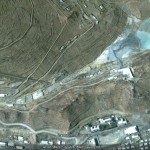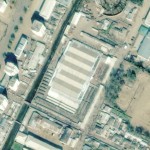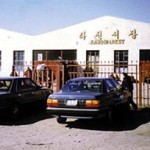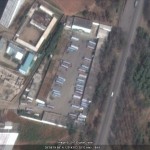UPDATE 2: According to Yonhap:
North Korea has inked a 10-year contract with British oil and gas company Aminex to explore and extract oil on the seabed off the country’s east coast, the Financial Times (FT) in London reported on June 1.
For the deal, North Korea presented Singapore-registered Chosun Energy as its representative to establish a 50-50 joint venture, Korex, with Aminex, the FT said, noting a filing with Singapore’s Accounting and Corporate Regulatory Authority.
Chosun Energy is an investment holding company operated by North Korea with a paid-up capital of US$1.2 million, according to the newspaper. But the newspaper did not elaborate further details on the company.
Korex will search for oil in an area of 50,681 square kilometers (20,272 square miles) in parts of North Korea’s east coast, Aminex said in a statement.
The contract with the British company, which is listed in London and Dublin, was signed around mid-May in London by officials from the North’s oil company and a head official for Aminex.
“Officials from North Korea’s state oil company traveled to London two weeks ago to conclude the 10-year contract. Lord Alton, chairman of Britain’s parliamentary North Korea group, says he showed the officials around parliament,” the FT added.
North Korea has contacted foreign companies and investors to attract foreign capital for searching for its rich natural resources, including crude oil. In 1997, the North claimed it had reserves of 5 to 40 billion barrels of oil.
North Korea has maintained ties with Animex since 1998. Aminex has been hunting for potential oil reserves in the North Korean portion of the Yellow sea since it signed with the country for joint oil and gas development in January 2005.
UPDATE 1: According to the AFP:
The head of a London-based energy firm that signed a deal to search for oil off North Korea said on Thursday he hoped to start exploring in a year but was closely monitoring tensions on the peninsula.
Aminex PLC executive chairman Brian Hall told AFP he expected “field work in about a year” off the communist nation’s east coast and aimed to “find substantial reserves”.
However, relations on the peninsula have become strained after North Korea was accused of carrying out a torpedo attack on a South Korean warship in March that left 46 sailors dead and stoked fears of an armed conflict.
Pyongyang has denied involvement in the sinking and threatened war in response to a trade suspension and other reprisals by the South.
Asked about the timing of the North Korea contract, Hall said “we have been working with (the) North Koreans for over a decade and an agreement such as the one we have recently signed takes many months to negotiate”.
He added: “Naturally we will keep a very close eye on the tensions on the peninsula, as we have done during previous incidents, but our project is of a long-term nature and well thought through.”
Aminex announced last week that an associate company had signed a 10-year contract with North Korea to search for oil in an area of about 50,681 square kilometres (20,272 square miles) in the Korean East Sea.
Hall declined to give an estimate of the potential deposits.
The contract was signed by Korex — a 50-50 venture between Aminex and Singapore-registered Chosun Energy — and the Korean Oil Exploration Company, the North’s state oil firm.
Victor Shum, an analyst with energy consultancy Purvin and Gertz, said there was every chance that oil would be found in the area but stressed the reserves must be of a significant size in order for exploration to progress further.
“The question is whether any oil reserves that may be discovered there are going to be economically viable to extract,” Singapore-based Shum told AFP.
“I think there has been interest certainly by oil companies so there is therefore a possibility of something there … So far the production isn’t large,” he said.
Aminex, with listings on the London and Irish stock exchanges, describes itself as an upstream oil and gas company with concessions in several countries including the United States, Kenya and Egypt.
According to a filing with Singapore’s Accounting and Corporate Regulatory Authority obtained by AFP, Aminex’s partner Chosun Energy is an investment holding company with a paid-up capital of 1.2 million dollars.
It listed its address as the German Centre in Singapore, a building that hosts small and medium-sized foreign companies, and named three directors — an American, one Briton and a Singaporean.
But staff at the German Centre told AFP the company had moved out.
Singapore is a major financial centre and corporate hub, attracting companies from all over the world because of the ease of doing business and access to funding.
North Korea, one of the world’s most impoverished countries, is starved of energy and foreign exchange after decades of isolation as well as economic sanctions, but is believed by US officials to have up to six nuclear weapons.
South Korea’s ban on most trade with North Korea in response to the ship sinking will cost the communist state hundreds of millions of dollars a year, according to figures from the Seoul-based Korea Development Institute.
ORIGINAL POST: According to the Financial Times:
Aminex, listed in London and Dublin, has formed a company, Korex, to pursue the project jointly with Chosun Energy, a Singapore-listed company that identifies James Passin as one of its directors, according to a filing with Singapore’s Accounting and Corporate Regulatory Authority.
Mr Passin is a New York-based fund manager. His Firebird Global Master Fund II half owns Chosun Energy and targets resource deals in frontier markets.
Officials from North Korea’s state oil company travelled to London two weeks ago to conclude the 10-year contract. Lord Alton, chairman of Britain’s parliamentary North Korea group, says he showed the officials around parliament.
Brian Hall, chairman of Aminex, acknowledged the contract had been concluded at a sensitive time given the rising tensions between Seoul and Pyongyang, but stressed he had opened ties with energy-starved North Korea in 1998. Since then, securing output rights from an exploration block had been “stop-go”.
Additional Information/thoughts:
1. Here is a previous short post on Aminex.
2. The economics literature overwhelmingly suggests that natural resource windfalls are generally bad news for weak states/developing countries—often fueling corruption, repression, and violence. The windfall almost never translates into better general working conditions or increases in general income (Botswana being an exception). There are plenty of papers out there making this point (“Natural Resource Curse”), so feel free to refer to your favorite.
3. I would be weary of building an offshore oil rig in the DPRK.
4. If oil is discovered in Korea’s East Sea, look for Japan, South Korea, and Russia to begin “drinking from their milkshake”.
Read the full stories here:
Oil firm says N.Korea exploration to start in a year
AFP
Bernice Han
6/2/2010
Anglo-Irish group seeks North Korean oil
Financial Times
Christian Oliver, Kevin Brown
6/1/2010




